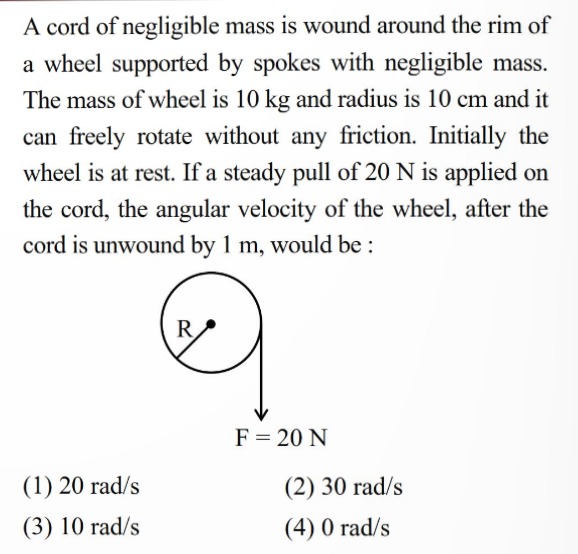Question
Question: A cord of negligible mass is wound around the rim of a wheel supported by spokes with negligible mas...
A cord of negligible mass is wound around the rim of a wheel supported by spokes with negligible mass. The mass of wheel is 10 kg and radius is 10 cm and it can freely rotate without any friction. Initially the wheel is at rest. If a steady pull of 20 N is applied on the cord, the angular velocity of the wheel, after the cord is unwound by 1 m, would be :

20 rad/s
30 rad/s
10 rad/s
0 rad/s
20 rad/s
Solution
The wheel is described as having negligible mass in its spokes and the mass of the wheel is 10 kg, distributed around the rim. This indicates that the wheel can be treated as a ring of mass M and radius R.
The moment of inertia of a ring about an axis passing through its center and perpendicular to its plane is given by I=MR2. Given mass M=10 kg and radius R=10 cm =0.1 m. The moment of inertia of the wheel is I=10 kg×(0.1 m)2=10×0.01 kg m2=0.1 kg m2.
A steady pull of F=20 N is applied on the cord, and the cord is unwound by a distance d=1 m. The work done by the force is W=F×d=20 N×1 m=20 J.
Initially, the wheel is at rest, so its initial angular velocity is ω0=0, and its initial kinetic energy is Kinitial=0. The work done on the wheel is converted into its rotational kinetic energy. According to the work-energy theorem, the work done is equal to the change in kinetic energy. W=ΔK=Kfinal−Kinitial 20 J=Kfinal−0 Kfinal=20 J.
The final rotational kinetic energy is given by Kfinal=21Iω2, where ω is the final angular velocity. 20 J=21×0.1 kg m2×ω2 20=0.05ω2 ω2=0.0520=100520=520×100=4×100=400 ω=400 rad2/s2=20 rad/s.
Alternatively, using rotational dynamics: The torque applied by the force F is τ=F×R=20 N×0.1 m=2 Nm. The angular acceleration α is given by τ=Iα. α=Iτ=0.1 kg m22 Nm=20 rad/s2.
The length of cord unwound d is related to the angle of rotation θ by d=Rθ. So, the angle of rotation is θ=Rd=0.1 m1 m=10 radians.
Using the kinematic equation for rotational motion: ω2=ω02+2αθ. Given ω0=0, α=20 rad/s2, and θ=10 rad. ω2=02+2×20 rad/s2×10 rad ω2=400 rad2/s2 ω=400 rad2/s2=20 rad/s.
Both methods give the same result.
